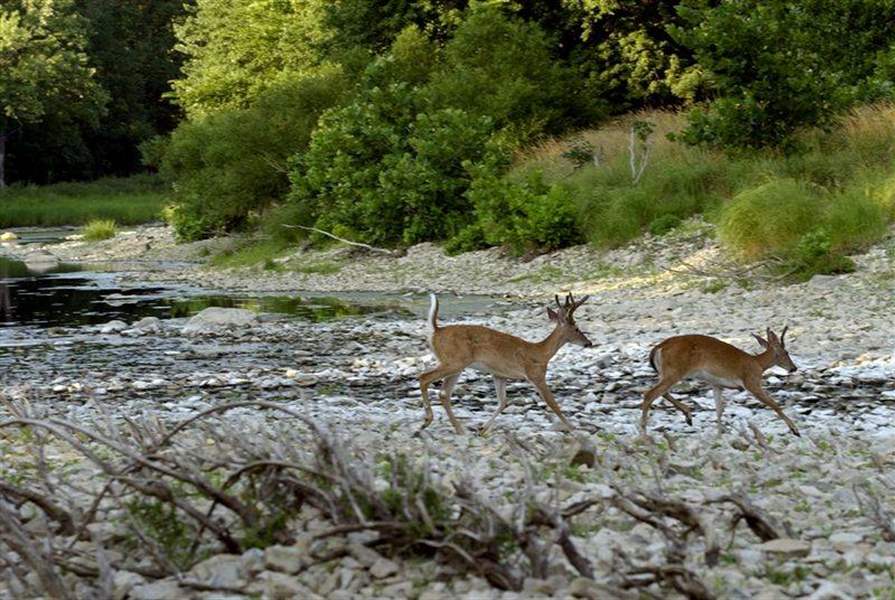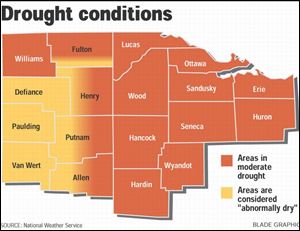
Farmers' prospects for profits drying up in region
8/3/2002
The water is so low in the Maumee River that deer can easily cross from the mainland to Blue Grass Island, across from Side Cut Metropark.
The National Weather Service made official this week what farmers and gardeners have known all summer: Most of northwest Ohio and the southeast tip of Michigan is in a drought.
The weather service had ranked the area as “abnormally dry” until Thursday when it put all but some of the western-most northwest Ohio counties into the “moderate drought” category.
“Nobody's going to have money to buy new equipment,” said Jim Beuerlein, a crop scientist at Ohio State University who has research plots in Wood, Henry, and Huron counties. “They're going to live with their old stuff for at least another year or two.”
In Ohio this week, 52 percent of the corn and 44 percent of the soybeans are considered “poor” or “very poor” by the U.S. Department of Agriculture. Last year at this time, 11 percent of the corn and 10 percent of the soybeans fell in those categories.
Conditions were not quite as bad in Michigan, where 29 percent of the corn and 26 percent of the soybeans were called “poor” or “very poor.”

The Maumee River at Waterville was at 2.3 feet, compared with the normal for this time of year of 2 feet.
But the percentage of crops called “poor” and “very poor” has risen almost weekly as important stages of the growing season pass with little to no rain. Through Friday, the only hope for rain that the weather service gives the Toledo area is a 40 percent chance of thunderstorms tomorrow nightand a 30 percent chance Monday.
Temperatures, however, will become noticeably cooler, falling into the 80s Monday and the upper 70s Tuesday and Wednesday, said Tom King, a weather service meteorologist.
Ted Huss, who farms about 300 acres near Genoa, predicted the drought “will cut the yield by half - if I'm lucky.” And if rain continues to elude him, Mr. Huss expects only a third of a crop.
From early June until last weekend, only about a half inch of rain fell on his soybean fields and the plants are short and struggling. He would have liked an inch of rain a week.
Most area farmers will harvest enough corn and soybeans to pay for their seed, fertilizer, and pesticides, Mr. Beuerlein said. But few will cover all their land and equipment costs and almost all will work for free.
If the area gets 2 inches of rain a week from now on, much of the soybean crop might still produce a near-average yield, he said.
But it's too late for most of the corn. Some corn is so stressed that it will not produce ears. Even plants that appear to be coping well are unlikely to produce top yields because the weather was too hot and dry during its reproduction cycle.
“There are some fields that look good that aren't going to be good and those that look bad are going to be really bad,” Mr. Beuerlein said.
Corn and soybeans are the area's biggest crops.
This week's drought declaration by the National Weather Service is part of the formula used by the federal government to declare local counties disaster areas and the process was started this week. But declarations from the Farm Service Agency, which distributes federal money to farmers, probably won't be made until September or October.
Such declarations, however, mean little to all but the most strapped farmers. Typically, living in or near a disaster area gives farmers the right to apply for low-interest loans - now at 4 to 5 percent - from the federal government. But loans are only given to those who are in such dire straits that private lenders refuse them.
Before recessing for the summer, Congress discussed extra help for farmers whose crops dry up in the drought.
Whether aid will be approved in the fall is uncertain. When Congress passed the farm bill this spring - which gives farmers more money than ever before under a plethora of programs - political leaders said it would be the only such aid. However, Congress has seldom stuck by such statements.
There are pockets in the area where crops appear fine.
Joe Box said the 1,400 acres he farms in Lucas County and the edges of Henry and Fulton counties is in a narrow band that has received several showers that most missed.
“I can't complain,'' he said. “This isn't a very big area that's gotten this type of rain.”
Across Ohio, the agriculture department called only 16 percent of the corn “excellent” or “good” compared to 61 percent last year. It gave those ratings to 19 percent of the soybeans, compared to 59 percent last year.
Landscapers and lawn care services are experiencing a tough summer too.
“We've probably lost pretty close to 60 percent of our revenue,” said Brian Miller, owner of Tender Lawn Care in South Toledo.
He hoped for high demand for lawn seeding this fall, but the profits he had hoped to make from work this summer are gone.
“It's the way Mother Nature is. There's not much we can do about it,” he said. “When you've lost something, you've lost it.”
The National Weather Service's drought designations are based on river and reservoir levels as well as soil conditions. But area waterways appear just as variable as farm fields.
In the canals of Jerusalem Township, the water level is 2 feet lower than the ideal.
“It's starting to get to be a problem for boats getting in and out of the channels,” said Matt Bourdo, dock manager of Anchor Pointe Boat-A-Minium.
Still, the water level in the channels is 11/2 feet higher than at this time last year, he said.
The Maumee River at Waterville was at 2.3 feet, compared with the normal for this time of year of 2 feet.
Blade staff writer Mark Zaborney contributed to this report.